Recently after a some deliberation in living with a undersized and under performing cooling system for 15 years, my family decided to replace our multi zone gas ducted heating and evaportative cooling system with a Fujitsu R2 High Static Cooling Solution (16.5 KW Cool / 20.5KW heating).
As usual lets start with a video to illustrate how this works, and all the moving parts in play.
This is not going to be a post about my HVAC system, but more so how I am driving efficencies with this system above and beyond the smarts inherit to the system. I am still learning and tweaking but in the past week I have settled on this. Our system has 6 zones (one for each of the 4 bedroom, upstairs living & downtairs) and that is controlled by a Polyaire Airtouch 5, and for most ‘normal’ people you would call it a day and be done. But, I am not normal.
The Airtouch 5 is a multi-zone solution, that speaks RS485 to my Fujitsu system allowing preceise control of each zone. Each zone has an individual temperature sensor, allowing unique temperatures. It also features the ability to define a % of the vents in each zone to be open, along with spill zones (If there is excess heat/cool capacity where to dump it). Very customisable.

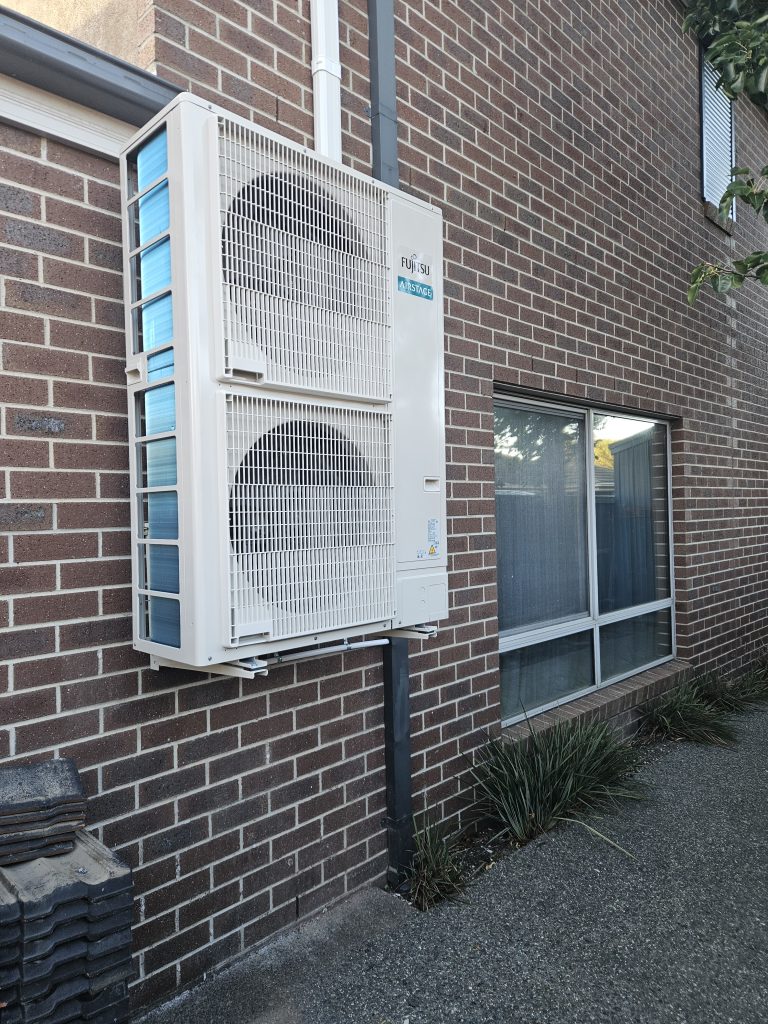
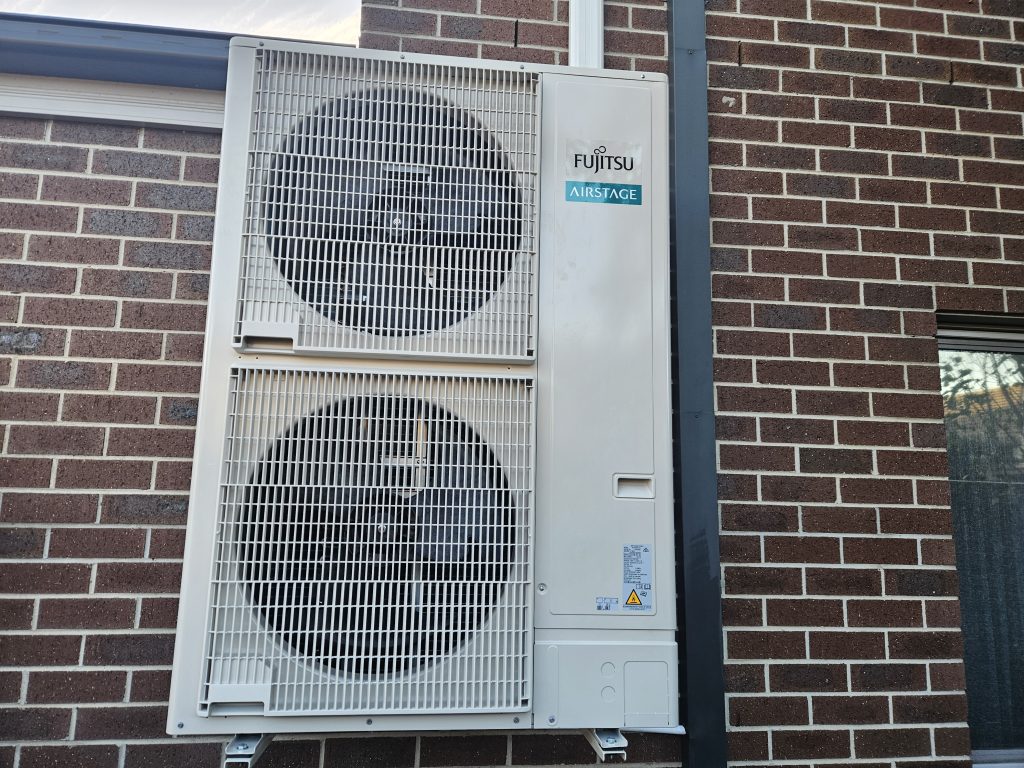

But it doesnt stop there. It has an API and a native Home Assistant Integation. It is a nice change to see manufactures being open and willing to ingerate with other sysems. The integration isn’t perfect (see below), but its pretty good.
There are a few challenges with a system of this nature
- Running costs. No skirting around this. I have seen this unit pull 5000W+ watts. In my local region (Victoria, Australia), that can equate to $2.00AUD per hour. Don’t get me wrong, when this system is in its sweet spot it is very efficient (~1000w or less).
- It doesn’t account for my kids leaving doors open, reducing effeciency
- Aggressive nature of trying to hit temperature map falling outside of Solar PV Array generation. It doesnt care or know about other aspects in the house.
We all need to make assumptions as builders. The assumptions that have been made by Polyaire and Fujitsu are fair, they cant assume I have all these bolt ons. So how can we take this further. Being a stickler for efficiency I have a few cards I can play
- Home Assistant Integration – AirTouch 5
- Alexa Media Player
- Door Sensors From Alarm System Locks & Zigbee Sensors
- Solar Array Information (Feed In Watts)
Data allows you to make finely honed decisions and this is going to form the basis of this post. Between the Fujitsu and Polyaire systems there is just not enough data.
In this post I am going to show you have you can drive efficiency in your HVAC system, reducing running costs and potentially increasing system lifespan.
The Plan
My plan is simple. It needs to just work, not get in the way of the family. Here are my tenets.
- Do – Maximise my usage of my solar feed-in. Where possible sacrifice the aggressive nature of hitting a temperature set point, staying within my feed-in budget.
- Do – Drive good behaviours with my kids (keep your rooms closed etc). Leverage Alexa and Mobile Phones for realtime alerts / feedback
- Do – Leverage the Polyaire AirTouch5
- Do – Maintain manual control planes (AirTouch 5 Tablet / AirTouch Android App)
- Do – Leverage existing control plane of Home Assistant and Amazon Alexa
- Don’t – Cool/heat rooms when there are no people present.
- Don’t – Cool rooms with doors open
- Don’t – Communicate directly to the Fujistu over RS485, everything needs to be an API call to the Polyaire AirTouch 5
Lets Get Building
To achieve the goal of doing this lets start with a high level architecture diagram. It may look complex but dont let it scare you, because it’s not.
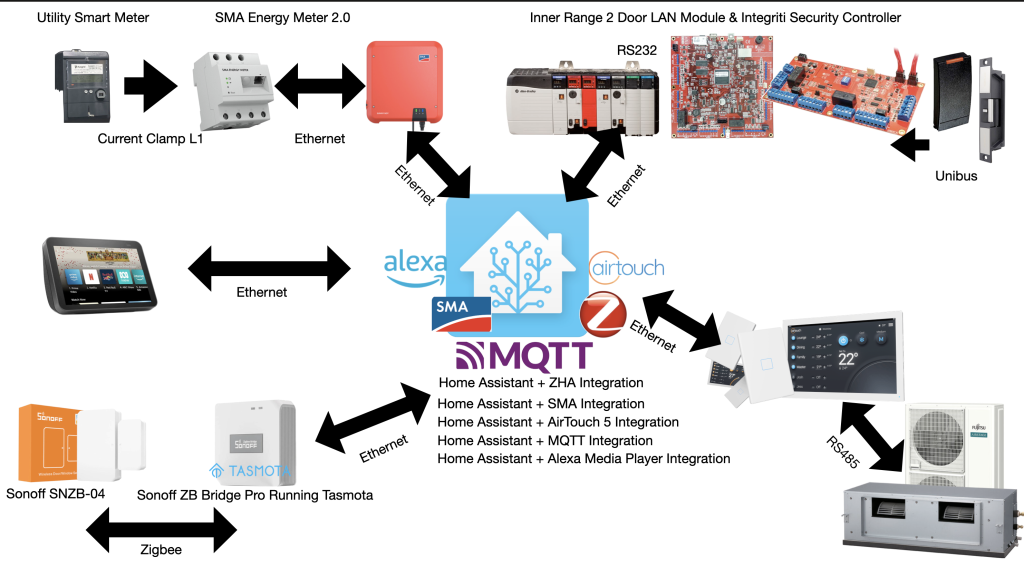
Fujitsu HVAC System Install
This post is going to be light on details on this part, but it’s me I can’t help myself. I used Cranbourne Air Conditioning to replace my ducted evaporative cooling and my ducted multi zone gas heating with a Fujistu whole house solution (Great work Michael and crew). The solution required a dedicated 32amp circuit on 6mm cable. My contribution to reuce costs was to run this circuit, install an isolator and RCD/MCB. I did the physical cable run (almost 40m) and had my friend (NewMark Electrical) inspect and terminate in the switch board. Electricity is dangerous, use a licensed electrician (at least in Australia).

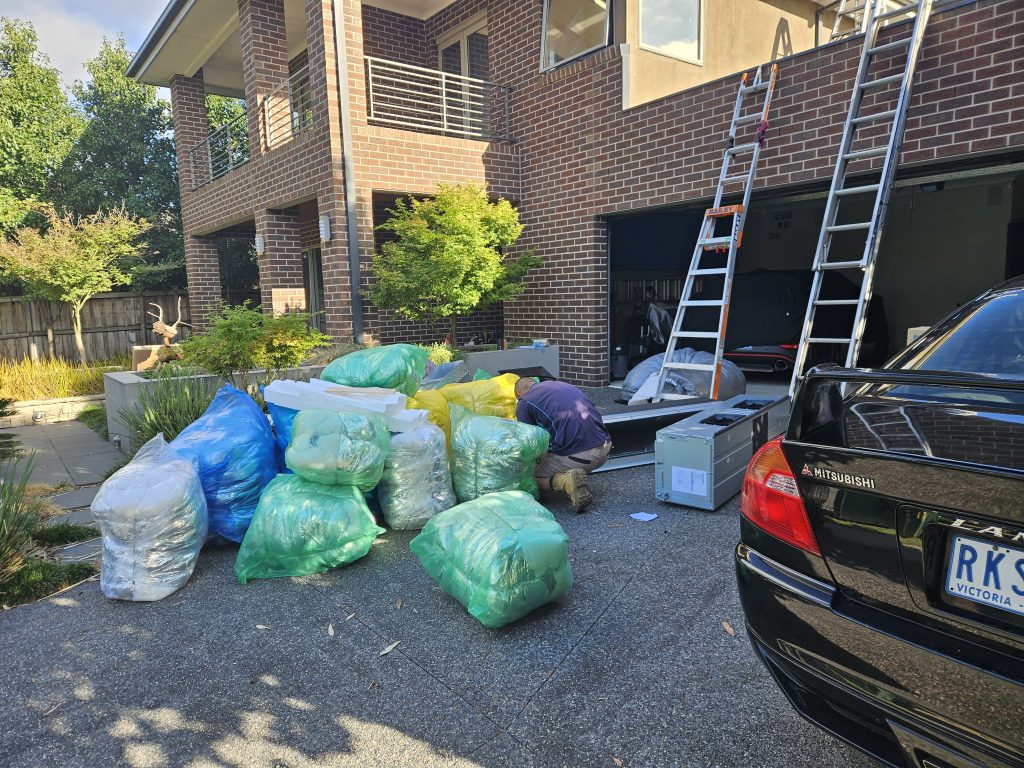
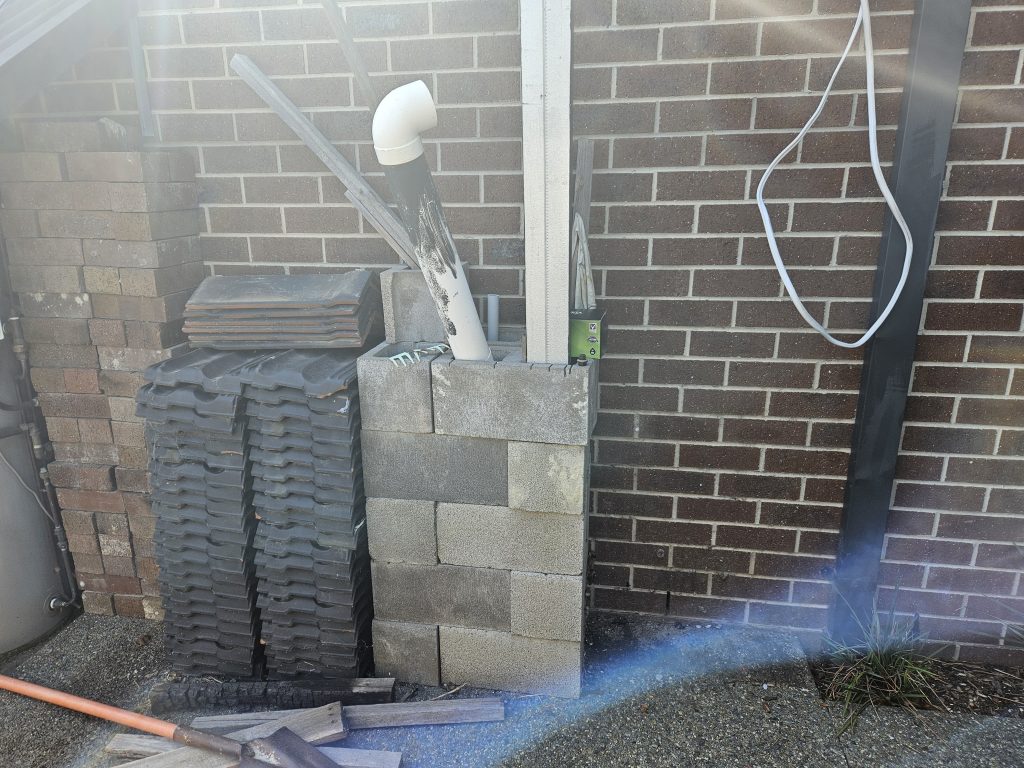

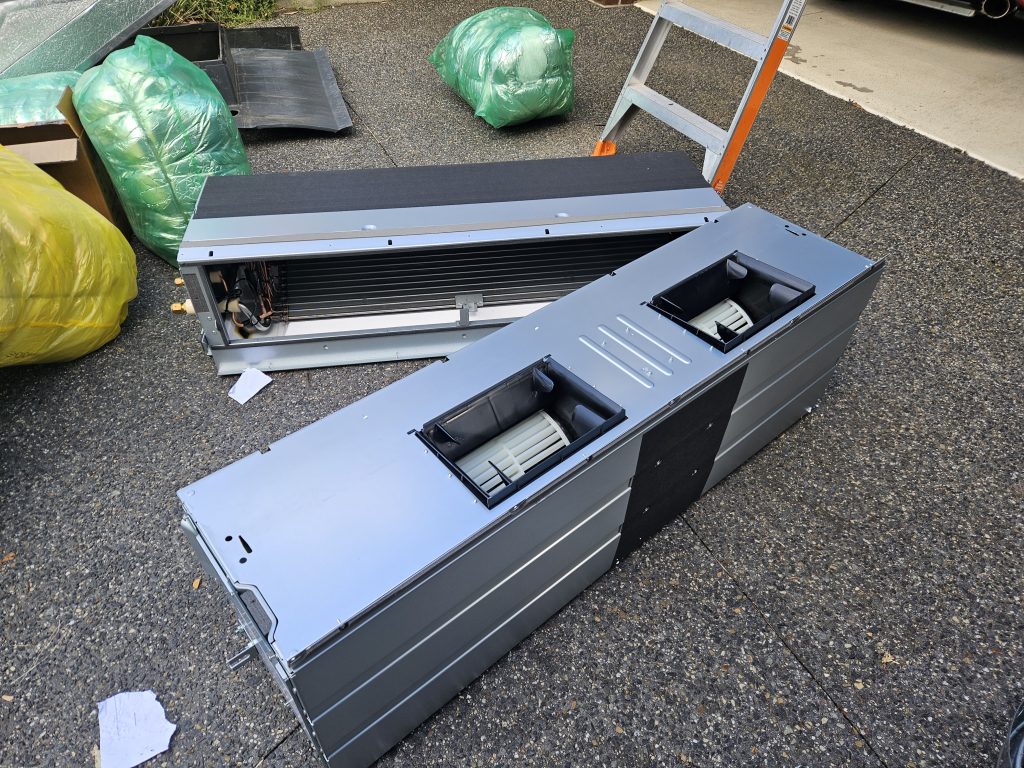
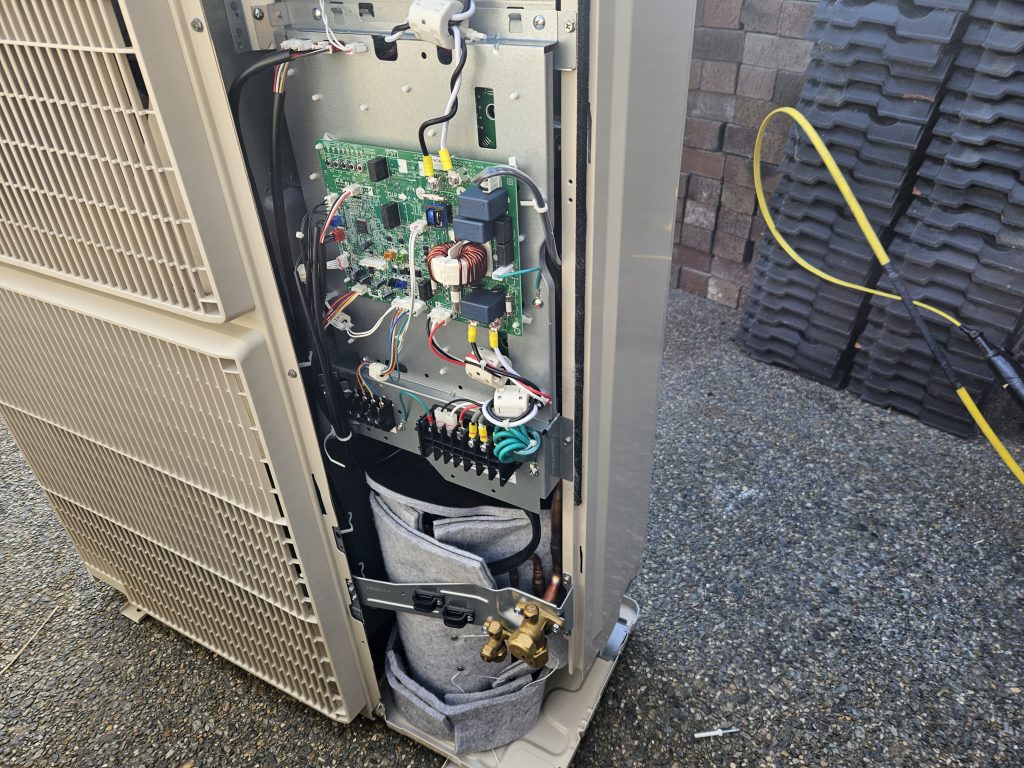
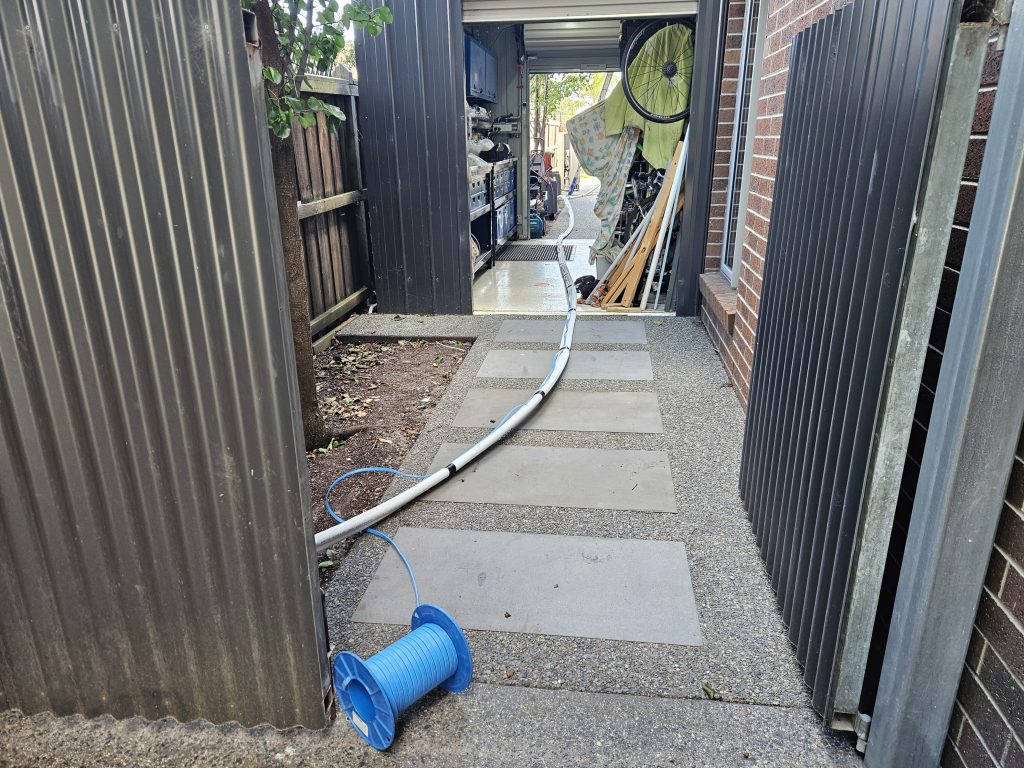

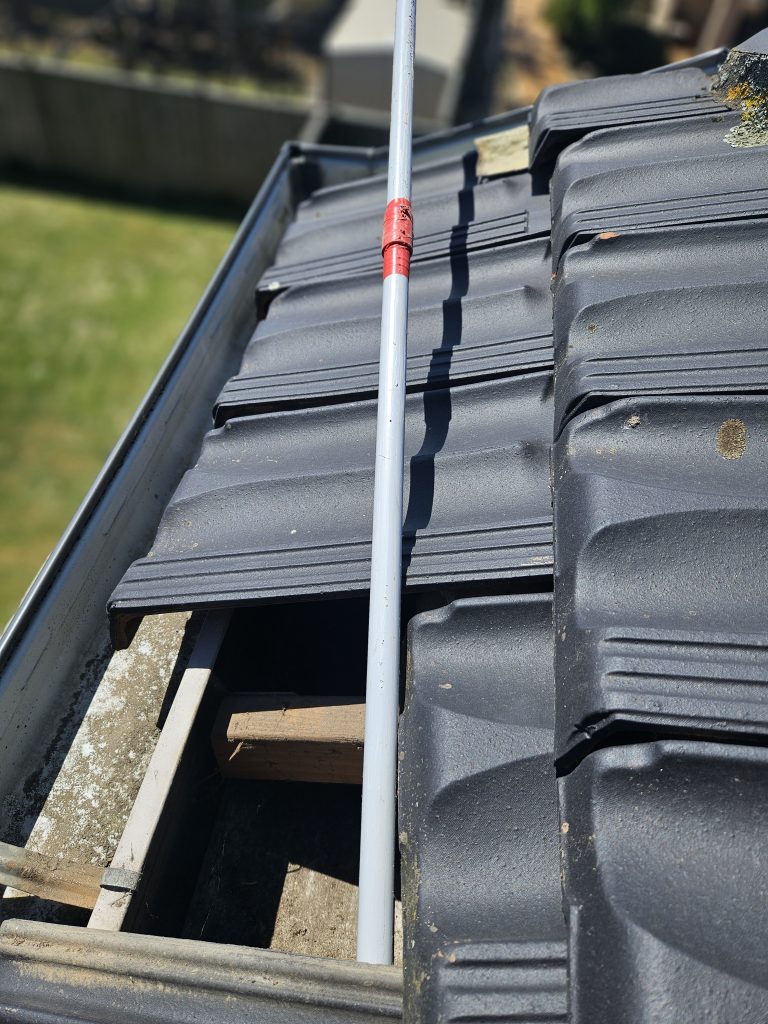
AirTouch 5 Integration To Home Assistant
The orchestrator in my house is going to be Home Assistant and in order to make this work the first step and the lynch pin in making this work will be having Home Assistant and the AirTouch 5 Gateway being able to communicate with each other. The good news is there is a native integration between Home Assistant and Air Touch 5 as of February 2024 (HA Core 2024.2). There are a few quirks that I am still struggling with but it is very usable. This integration does not require HACS, it is native. You will need to obtain the IP address of the Android tablet. This can be done either via your DHCP server or via Wifi settings on the Android device. I suggest you set this as a static IP or a reservation in your DHCP server.
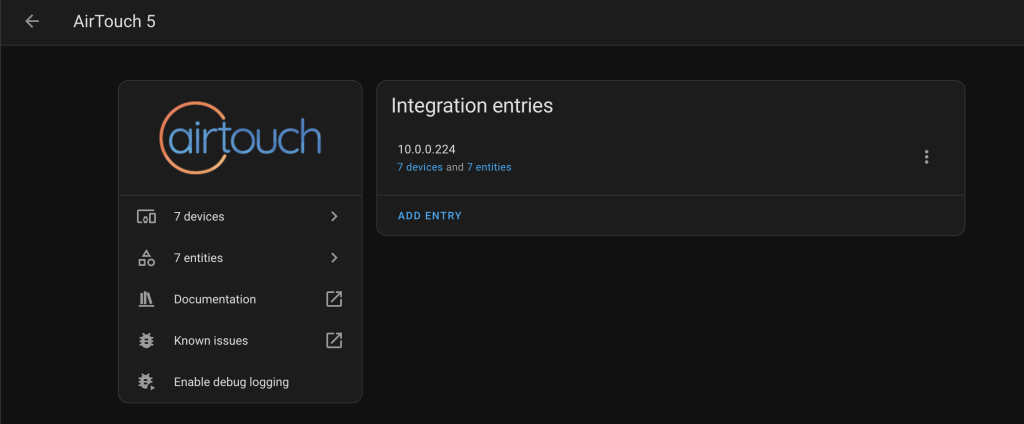

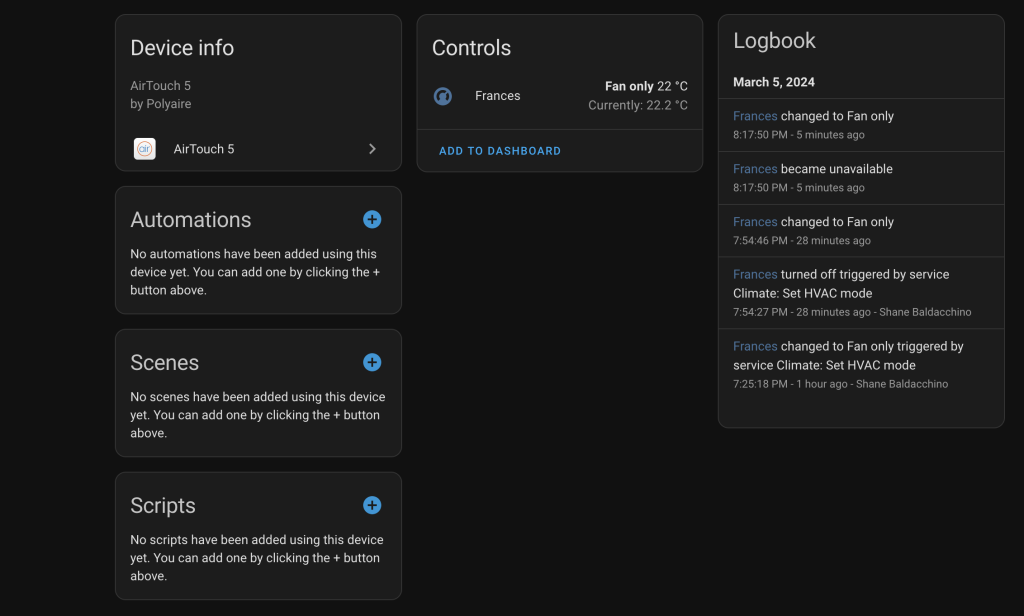

It will list all of your zones and provide you the function to change the thermostat on your HVAC system. This includes getting and setting the fan speed and function [cool, heat, dry, fan, auto] along with setting the temperature of each individual zone. What I have not been able to do thus far is report back the temperature in each ITS (Individual Temp Sensor) as Home Assistant entity (more on that below)
Are Doors Open Or Closed?
I need to understand the state of the doors. I have two types of doors in my house. Entry and exit doors, these are controlled by Inner Range Integriti alarm system with FSH Electric Strikes, and then we have normal doors inside the house (bedrooms / bathrooms etc).
The Inner Range maintains a log that it spits out over the serial port (RS232) to my PLC which I already use to take action. The flow for this is as follows.
FSH Electric Strike <–> Inner Range Door Controller <–> Inner Range Integriti <– RS232 –> PLC <–> MQTT <–> Mosquitto <–> Home Assistant

For regular doors, I am using wireless Zigbee door sensors in the form of a Sonoff SNZB-04 Zigbee Wireless Door Sensor. They are powered by a CR2032 and 3M tape, two technologies I have my hesitations about. The SNZB-04’s reports it status and battery voltage. I am hoping its an annual (or longer) battery replacement schedule.
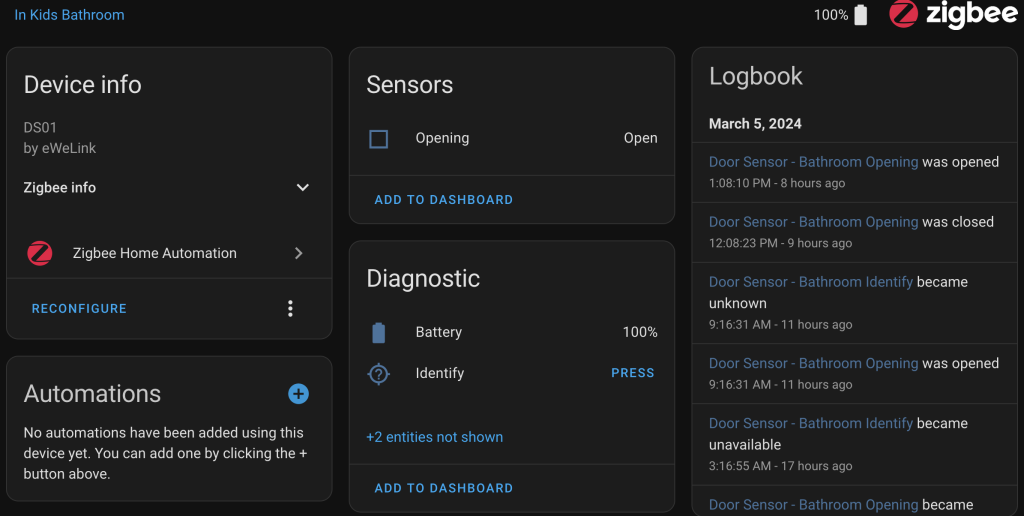

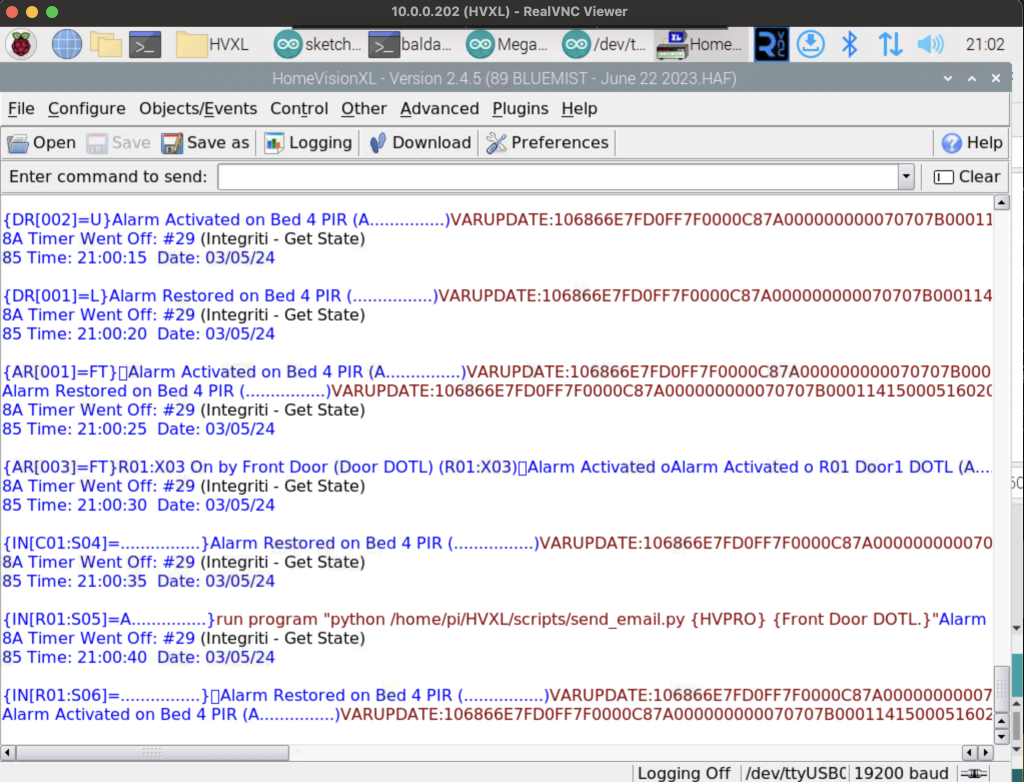


The flow for this style of door (internal) is as follows
Sonoff SNZB-04 Door Sensor <–> Sonoff Zigbee Bridge Pro (Tasmota) <–> ZHA <–> Home Assistant

Is The Sun Shining – What Is The Power Budget.
My whole house solution whilst incredible efficient for what it is, can consume a lot of power. This unit is the largest single phase HVAC system I could get. It can draw 21.1 AMPs (240v * 21.1) which is 5064w. My solar array presently has 7500w of panels on a 6000w inverter. My goal here is to ‘ideally’ where possible to stay within the budget of my generation. In a past post I detailed how I am making decisons in my house based on solar generation. I wont be going in to a lot of details. I suggest you read the following post. The summary of this is you need an integration solution in to not only your invertor, but also your smart meeter. I am using the SMA Energy Monitor. The SMA Energy Monitor integrates as follows
Power Utility Smart Meter <–> SMA Energy Meter <–> SMA Energy Meter <–> SMA Inverter <–> Home Assistant –> MQTT StateStream –> Consuming Solution (Home Assistant)
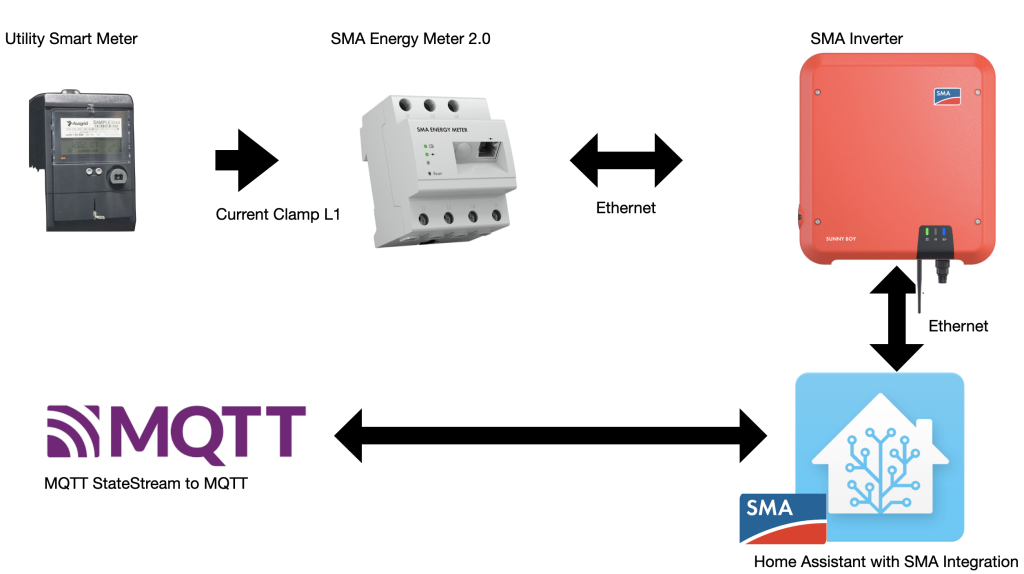
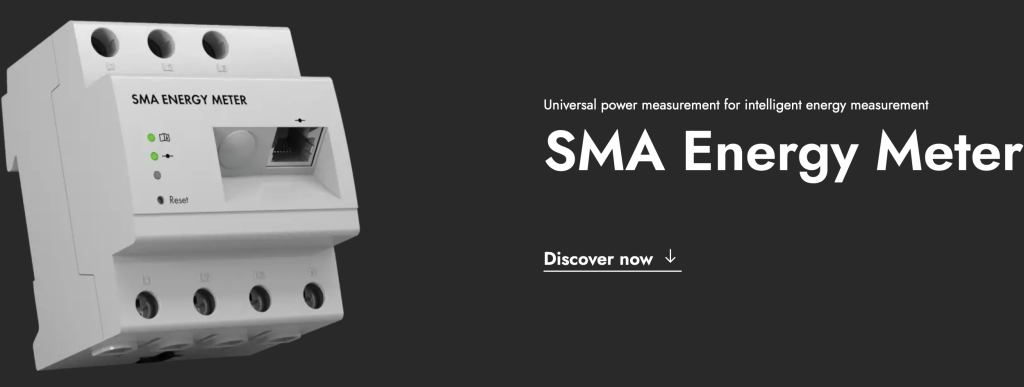
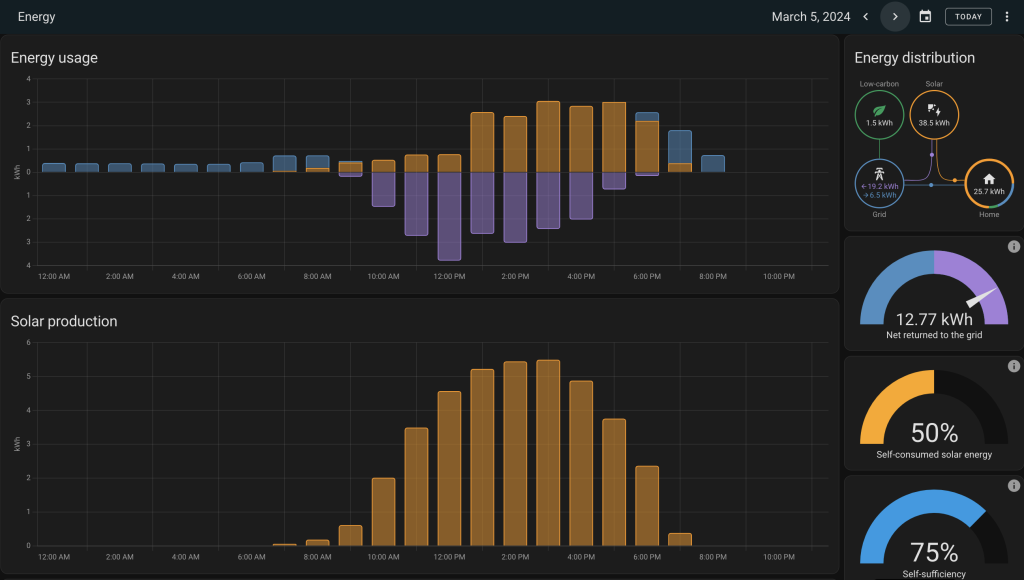
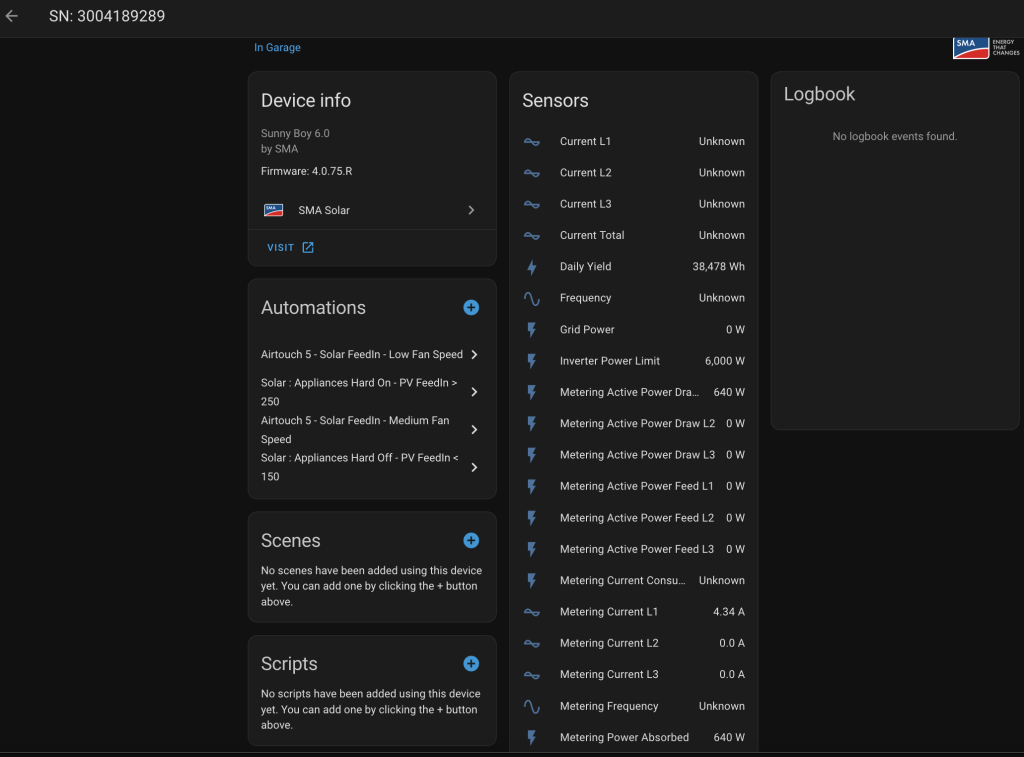

With a 1hz resolution, there i plenty of resolution to make decisions. So what are my levers I can pull. I am not going to stop heating or cooling (would never be family approved) but what can I do? I can control the fan speed. Between low, medium and high there is a variance of > 1000w (It is still early days and I dont have enough data, it may be as much as 2000w).
So with this lever what I will be doing is detecting both the status of the HVAC (Cooling / Heat) and evaluating that against the statistics from the energy meter (Grid Draw / Feed-in) and adjusting the fan speed accordingly. I am not going to be changing fan speeds every 1 second (1hz) but am adjusting every 3 minutes.
Notifications
When an event we wish to notify on, we need to send messages so that ‘said’ issues can be resolved. In a prior post I leveraged Alexa Media Player to send notifications to Alexa. My house has 11 Alexa devices, one in every bedroom, one in the upstairs living and some others scattered from the shed to the kitchen and beyond there is coverage. We also have phones (my wife and some of my children). Whilst I could blast all devices, this scattergun approach would cause resentment and more so they would be deemed noise.
The approach I am taking is to have a mapping of a notification to the given rooms Alexa along with common room Alexa’s depending on time of day and finally, if the room is mapped to a person (example my son’s room), then if they have a device, they receive a notification
On notifications I take a two stage approach (for now)
- [3 minutes of door being open with HVAC on] – A warning. A message is sent stating a specific door has been left open and to please close the door
- [5 minutes of door being open with HVAC on] – The zone in question is turned off. This will require the zone again to be turned back on (AirTouch 5, Alexa or Home Assistant)
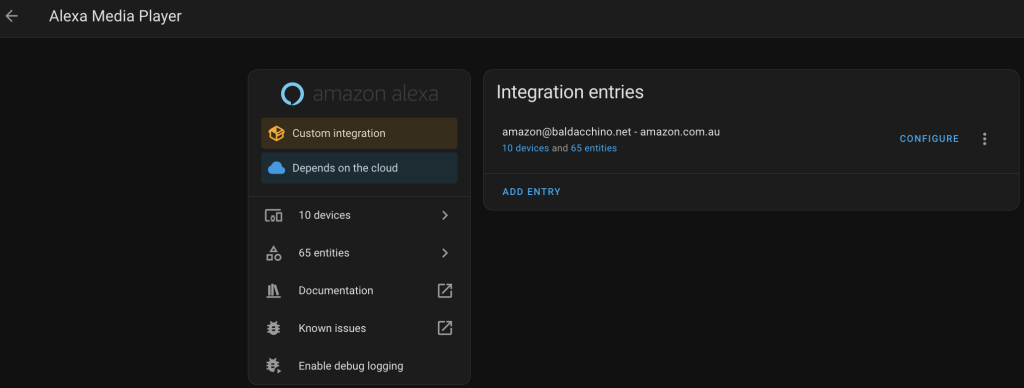

The Solution – Pulling It All Together
The wrapper for all of this will be Home Assistant and it will be a Home Assistant automation. I have two style of automations. DOTL (Door Open Too Long) automations, to which I have one automation per zone and a single automation to detect solar feed-in.
These are really simple automations.
- If DOTL > 3 minutes and HVAC is on in a specific zone. Then send a warning to specific devices
- If DOTL > 5 minutes and HVAC is on in a specific zone. Then turn off the zone
- If grid draw > 0 watts, set fan speed to low




My pseudo code can be elaborated upon using YAML from Home Assistant.
alias: Airtouch 5 - DOTL - Oscar - 3 Minutes - Warning
description: ""
trigger:
- type: opened
platform: device
device_id: cae04bd921402733ff2d641728860db3
entity_id: 44435d5623ec32e816e63a275feb2a57
domain: binary_sensor
for:
hours: 0
minutes: 3
seconds: 0
condition:
- condition: device
device_id: bacd802a38de00ba293607be439b86e8
domain: climate
entity_id: 978a4edfb808d538fe25345ca95c45df
type: is_hvac_mode
hvac_mode: fan_only
action:
- service: notify.alexa_media_kitchen
data:
message: The HVAC is on. Please close Oscar's door
data:
type: tts
enabled: true
- service: notify.alexa_media_parents
data:
data:
type: tts
message: The HVAC is on. Please close Oscar's door
enabled: true
- service: notify.mobile_app_sm_s916b
metadata: {}
data:
message: Oscar's door has been open for more than 3 minutes with the HVAC on
- service: notify.alexa_media_shane_s_3rd_echo_show_5_2nd_gen
data:
data:
type: tts
message: The HVAC is on.- Please close your door Oscar
enabled: true
mode: single
alias: Airtouch 5 - DOTL - Oscar - 5 Minutes - Off
description: ""
trigger:
- type: opened
platform: device
device_id: cae04bd921402733ff2d641728860db3
entity_id: 44435d5623ec32e816e63a275feb2a57
domain: binary_sensor
for:
hours: 0
minutes: 5
seconds: 0
condition:
- condition: device
device_id: bacd802a38de00ba293607be439b86e8
domain: climate
entity_id: 978a4edfb808d538fe25345ca95c45df
type: is_hvac_mode
hvac_mode: fan_only
action:
- service: notify.alexa_media_kitchen
data:
message: >-
Oscar's door has been open for more than 5 minutes. His HVAC zone has
been turned off.
data:
type: tts
enabled: true
- service: notify.alexa_media_parents
data:
data:
type: tts
message: >-
Oscar's door has been open for more than 5 minutes. His HVAC zone has
been turned off
enabled: true
- service: notify.mobile_app_sm_s916b
metadata: {}
data:
message: >-
Oscar's door has been open for more than 5 minutes. His HVAC zone has
been turned off
- service: notify.alexa_media_shane_s_3rd_echo_show_5_2nd_gen
data:
data:
type: tts
message: >-
Oscar's door has been open for more than 5 minutes. His HVAC zone has
been turned off
enabled: true
- device_id: bacd802a38de00ba293607be439b86e8
domain: climate
entity_id: 978a4edfb808d538fe25345ca95c45df
type: set_hvac_mode
hvac_mode: "off"
mode: single
alias: Airtouch 5 - Solar FeedIn - Medium Fan Speed
description: Set the fan speed to if > 1000 watts of feed in
trigger:
- platform: numeric_state
entity_id:
- sensor.metering_active_power_feed_l1
for:
hours: 0
minutes: 3
seconds: 0
enabled: true
above: 1000
condition:
- condition: or
conditions:
- condition: device
device_id: 445725a14df6eb35d0956298ff636928
domain: climate
entity_id: 353f971a70aaa6fda6955325cf85faae
type: is_hvac_mode
hvac_mode: cool
- condition: device
device_id: 445725a14df6eb35d0956298ff636928
domain: climate
entity_id: 353f971a70aaa6fda6955325cf85faae
type: is_hvac_mode
hvac_mode: heat
action:
- service: climate.set_fan_mode
metadata: {}
data:
fan_mode: medium
target:
device_id: 445725a14df6eb35d0956298ff636928
mode: single
alias: Airtouch 5 - Solar FeedIn - Medium Fan Speed
description: Set the fan speed to if > 1000 watts of feed in
trigger:
- platform: numeric_state
entity_id:
- sensor.metering_active_power_feed_l1
for:
hours: 0
minutes: 3
seconds: 0
enabled: true
above: 1000
condition:
- condition: or
conditions:
- condition: device
device_id: 445725a14df6eb35d0956298ff636928
domain: climate
entity_id: 353f971a70aaa6fda6955325cf85faae
type: is_hvac_mode
hvac_mode: cool
- condition: device
device_id: 445725a14df6eb35d0956298ff636928
domain: climate
entity_id: 353f971a70aaa6fda6955325cf85faae
type: is_hvac_mode
hvac_mode: heat
action:
- service: climate.set_fan_mode
metadata: {}
data:
fan_mode: medium
target:
device_id: 445725a14df6eb35d0956298ff636928
mode: single
AirTouch 5 Home Assistant Integration – Limitations (March 2024)
There are limitations with the AirTouch 5 integration, if anyone from Polyaire is reading this, there are gaps. Please fix them ;). It makes it hard to fully use Home Assistant if you are not exposing all functionality. My expecation is you expose every sensor as an entity so I can take leverage them how ever I wish to.
- There is no ability to alter the fan speed on the gateway. Incredibly frustrating. I found away to get around this by using an automation to “Call a service ‘Climate: Set fan mode’ on AC0” sending a text data string of ‘low’. This was undocumented, not part of the entity and just a guess.
- Home Assistant only can see 3 fan speeds, yet I can define far more on the gateway (installer section)
- I can’t use the ITC (Individual Temp Sensors) as an entity.
Polyaire, come on, this data would be incredibly helpful. If you want to be more than Australia’s smartest Wifi & App Enabled Air Conditioning Controller solve these minor issues.
Polyaire, whilst this sounds like a criticism, I applaud you for creating an integration and not confining users to their application (AirTouch 5)

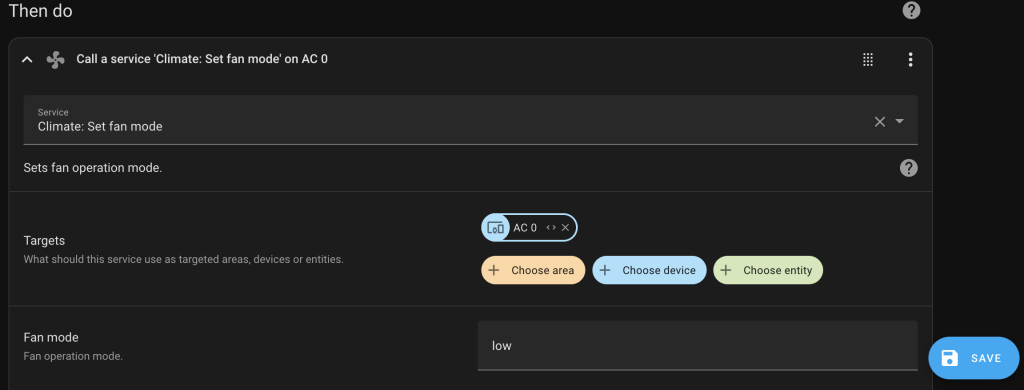
Summary
We all need to look to drive efficiency in solutions. Be it developing a solution in the cloud, or building designing a HVAC system. Coupled with door sensors and an orchestrator, with a few tweaks we can achieve a better outcome, save money and increase the lifespan of our devices. This solution means I am heating and cooling, only in rooms with closed doors and not letting my climate system escape out the door and where possible staying within my power budget.
The reality is integration can be some what hard work, maybe even daugnting, but it doesn’t have to be. Get your hands dirty and give it a go.
Thanks
Shane Baldacchino


Great work Shane! It must have been frustrating to get this far and not be able to work with each component in the AirTouch 5 system.
I hope they(Polyaire) expose these, as it’s a deal breaker to buy a system like this and not be able to optimise it to it’s full potential. I would imagine it’s only a matter of time until something comes along to provide this.
I know, the ITC’s not being entities are still an issue. I have not seen any updates to their integration.
Are you running an AirTouch David?
As an FYI, your Fujitsu will have an external input for power control where you can trigger the outdoor unit to utilise 50% or 75% of the maximum power. This is triggered via a 12v or 24v input. You’d have to look it up in your installer’s manual, but I have the one model up from you, the ARTC72LATU and have wired a 24VDC LED driver connected to a shelly Plus 1 relay device that current limits the 24 VDC to 10 ma going into the external input CN131 on the inverter board (install manual https://webstore.uk.fujitsu-general.com/product/attachment/AJY108LALBH/installation%20manual.pdf)
Setting the inverter board settings to 50% power, I can remotely reduce the power consumption of the unit to 50% to help spread the power draw over a longer period of time vs having high intensity heating / cooling in small bursts.
Awesome M. I need to do this. So low noise operation mode. For CN131 (I will pull the cover off soon) is there two terminals or from a relay (like Shelly Plus 1 ) I go between CN131 and a ground on the PCB or is there two terminals in CN131. I will take a look but appreciate any tips
Hi Shane, great work. I have just installed a panasonic based AirTouch system and came across your site while looking for ideas for automations… youv’e given me some great ideas.
I’m wondering if you wouldn’t mind posting your dashboard code as I’m not sure how to get the AC0 info displayed.
Hey Mark,
My lovelace code is as follows
type: thermostat
entity: climate.ac_0
features:
- type: climate-hvac-modes
hvac_modes:
- 'off'
- auto
- cool
- dry
- fan_only
- heat
- type: climate-fan-modes
style: dropdown
fan_modes:
- low
- medium
- high
- auto
name: Fujitsu 16.5 KW
Now for each zone I have
type: tile
entity: climate.zone2
features:
- type: climate-hvac-modes
hvac_modes:
- 'off'
- fan_only
- type: target-temperature
But you should be able to get this from the Airtouch 5 integrations.
Reach out if you need more help.
Shane
thanks a lot
This is a great article Shane. I stumbled across it while trying to get a better feel of how good the integration is back into HA. Let’s hope they continue to build on it.
You’ve got me thinking now with getting some door sensors now.
Thanks again,
Alex
Thanks Alex,
Yeah door sensors are handy, I am finding not being hard wired (I do for almost everything) battery changes are starting to be a hassle. I am getting 6 or so months per CR2032.
Btw nice pics on your website.
Shane
Love your post, thanks for taking the time to write this up. I have something similar at my place and have been using this HACS integration for the AirTouch, I’ve found it more flexible than the built in one.
https://github.com/TheNoctambulist/hass-airtouch
You made my day with that comment. The HASS i integration looks heaps better. I always wanted to get the temperature out from zones as entities.
Thank you!!
I just installed this. Sooooooo much better.